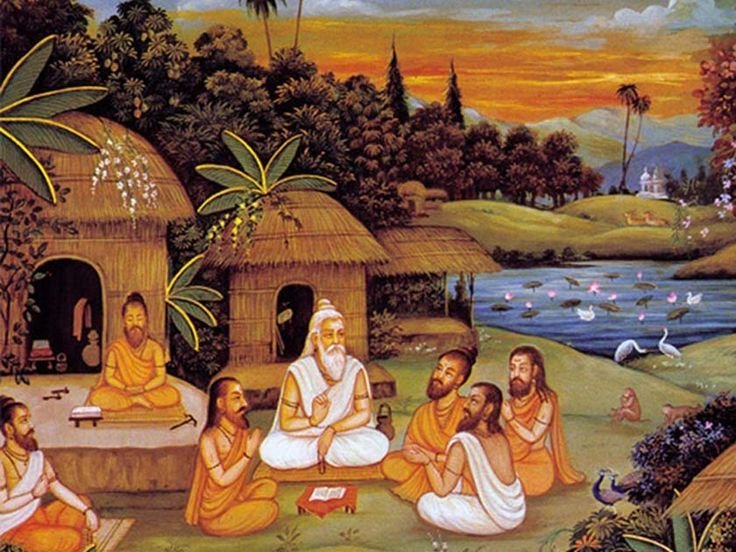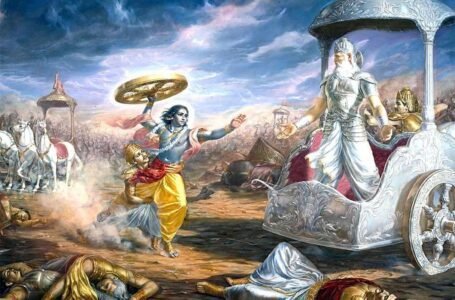Between Hearth and Horizon: The Everyday Table of Ancient India

-Vani Mishra
Civilization’s past is not carved on stone. Nor is it written only on the walls of temples or the gates of great cities, nor indeed in the annals of kings and tales of their victories. A civilization is as much in the bubbling clay pot over a low flame, in the dust of the grain between grindstones, in the aroma that wafts out of a kitchen door. In asking what common people in ancient India ate each day, we are not simply listing a menu. We are entering the privacy of their everyday life, into a realm where food was nourishment, piety, and a connection between neighbours and ages.
The Vedic Hearth
We start our journey in the Vedic period, over three thousand years ago. For them, food was not just physical nourishment but a gift to the gods. Mere eating was a ritual-bound act. Cereals were in the middle of the table, mostly barley in the earliest period and then rice. Barley was boiled, crushed, and sometimes roasted, whereas rice too came to be eaten in soft, perfumed heaps. Wheat was known but less central during the first few centuries. Milk, curd, butter, and even ghee flowed generously. These were not only food items but sacred substances which were present in prayers, sacrifice, and ritual offerings. Meat did not entirely lack the Vedic diet. Hymns of early times refer to cattle, goat, and sheep being cooked on the occasion of celebrations, especially to welcome guests or as a part of religious rituals. These were not daily fare but dishes reserved for occasions when roasting smoke blended with altar smoke. Fish and game contributed variety in forest and river countries. Spices in the way we know them today played a smaller part in the earlier centuries. Flavour was derived from the quality of the ingredients and the richness of dairy foods. Salt was valued and others such as mustard and garlic were familiar, even though garlic sometimes remained reserved on ritual purity grounds.
Fields, Gardens, and New Tastes
With the passage of centuries and the extension of the Vedic civilization towards the fertile Gangetic plains, the diet evolved. Rice not only emerged as a staple food but a symbol for prosperity and fertility in society. Lentils and pulses such as mung, masur, and urad entered the daily lives and were pivotal protein sources for the growing population. Sesame in seed as well as oil form was used in foods and rituals. With permanent agriculture, orchards, and gardens. Mangoes, jackfruit, bananas, and pomegranates in repeating cycles of seasons. Sugarcane was cultivated; the juice concentrated into syrups or consumed fresh. Honey was still precious, gathered from wild bees’ hives and put away for medicine, sweetness, and ritual purposes. Increasingly, there were a greater number of techniques for cooking. Food could be boiled, roasted, fried, or steamed. Wheat flour became the material for flatbreads and thicker griddle cakes in the north, but rice remained the mainstay east and south. Fermentation became a part of kitchen practice, producing sour batters and faintly alcoholic brews.
The Mauryan Table
By the period of the Mauryan Empire in the fourth to second centuries BCE, cities in India were significant crossroads for trade. Pataliputra, the capital, was a confluence of farmers, merchants, and visitors coming in from all parts of the subcontinent. Market stalls bore an assortment of grains, vegetables, and fruits, some of them from distant parts. Although the diet remained largely comprised of grains and pulses, pepper, cardamom, coriander, and cumin added variety to flavours. Outside of their season, the elite could enjoy white polished rice, rich ghee cakes, and preserved fruits. The art of drying and storage had improved, and commerce brought spices and available ingredients from places far away. Meanwhile, Buddhism and Jainism spread new values, among them the practice of ahimsa, or non-violence, which led a good number to switch to vegetarian diets. This change was gradual, and meat never came off every plate, but the culture began to make vegetarianism a moral choice.
The Village Kitchen
Beyond the city walls, in the villages that dotted the countryside by the thousands, the eating was linked directly to the life of agriculture. The hearth was not hidden but was a dominant feature of the house, binding people to their flocks and fields. An ordinary day could begin with leftover grain from the previous night, warmed and eaten with curd. The lunch was typically: fresh rice or millet with plain lentil soup and such seasonal veggies, leafy greens, or gourds as were in season. Pickles and chutneys added a sour, preservative zing, typically from tamarind, mango, or lemon.
Mealtimes were collective. People sat on the floor, mostly on mats of woven leaves, and dined on plates from stitched leaves. Hospitality was a duty and not a privilege; even a family that was very poor would give their guest curd rice, a chunk of jaggery, or a glass of buttermilk.
Season and Sacredness
Food in ancient India could not be separated from ritual and festival calendar. Some foods were cooked especially for certain occasions. Rice pudding with ghee and jaggery was reserved for harvest festivals. Sweet sesame balls surfaced at winter solstice, when one yearned for Vigor and warmth. Fasting days were followed by permitted foods, like fruit, nuts, and boiled root vegetables. Seasonal awareness guides the menu. In the summer heat, people enjoyed cooling foods like curd, cucumber, and melon. In winter, richer foods like sesame sweets and breads spread with ghee were chosen. Feasting was not so much a matter of hunger but a procedure of putting the body in balance with the movements of nature.
Tools and Techniques
The kitchen appliances told as much as the recipes did. Flat grinding stones ground grain into flour and pulses into silky paste. Mortars and pestles released the fragrance of freshly pounded spices. Clay pots enabled slow-cooked cuisines, offering a richness of flavour and softness that the kettle could not provide. Imparting food with a subtle smokiness, cooking on open fires is a flavour hardly achieved by modern stoves. To Ayurvedic thought, taste itself was a route to wellness. The perfect dish had all six flavours-mildly bitter, sour, salty, pungent, bitter, and astringent-all in harmony, which sustained body and soul. Even the humble rice and lentil could be tweaked to offer balance in flavour and impact.
The Living Legacy
The reverberations of earlier Indian foodways still echo in contemporary kitchens. The thali, with its harmony of tastes and textures, perpetuates the ancient ideal of completeness in a meal. The cultivation of seasonal produce, the focus on fresh preparation, and the blending of sacred and mundane meanings persist from those formative centuries. New crops like chickpeas and spinach appeared on the table over time. New influences came in, from Persian pomegranate molasses to Portuguese-introduced chilli. And yet throughout it all, the abiding understanding of food as relationship to land, to community, to the divine has endured. Ask what ancient Indians ate every day, and you will find more than a menu. Enter homes wherein grain was shaped into bread with patient hands, in which conversations and laughter chased the moving bowls, a meal was an action of thanks and connecting. In these kitchens, history simmered slowly, and in their fragrance, we can still catch the living soul of a civilization.


